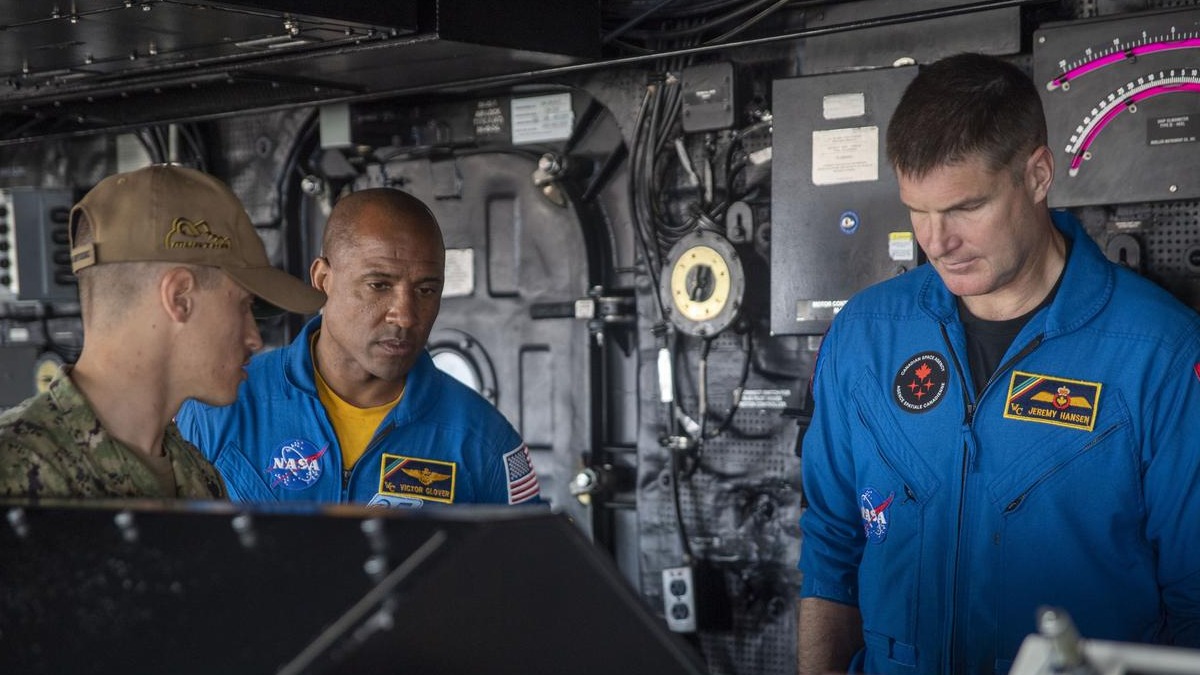See Artemis 2 moon astronauts train with US Navy for Orion splashdown (photos, video)
Moon missions also require water operations.
A safe moon mission requires getting in the water first.
The four astronauts of Artemis 2 recently visited the U.S. Navy team that will recover their spacecraft from the ocean next year, to meet with recovery operators and get set for training. The quartet are scheduled to fly around the moon no sooner than November 2024.
NASA and the Department of Defense also practiced recovery off the coast of San Diego this month using boats, helicopters and the USS John P. Murtha warship for sea operations. While Artemis 2 crew members were not at sea this time, that will be happening soon.
"The U.S. Navy has many unique capabilities that make it an ideal partner to support NASA," military officials stated alongside a video of recovery operations. The Navy highlighted its "amphibious capabilities", including sending helicopters, using 3D air search radar and providing high-quality medical care in remote sea environments.
Related: Artemis 2 moon astronauts visit splashdown zone for their Orion spacecraft (photo)
By coincidence, half of the Artemis 2 crew are Navy officers themselves. Both commander Reid Wiseman and pilot Victor Glover are Navy captains.
The other two crew members are Canadian Space Agency astronaut Jeremy Hansen (a colonel in the Royal Canadian Air Force) and NASA astronaut Christina Koch, who in her last career overwintered in Antarctica several times for science.
Breaking space news, the latest updates on rocket launches, skywatching events and more!
The diverse crew includes a lot of firsts for humanity on a moon mission: Glover will be the first Black astronaut to leave low Earth orbit, while Koch is the first woman and Hansen the first non-American.
For this first moon mission in 52 years, NASA is trying to get direct training advice from operational team members of Artemis 2. This practice not only brings in direct experience, but the astronauts can also team-build with their instructors ahead of hearing their voice on the line from a distance.
"We liked the fact that (trainers) can come in and say, 'I'm going to give you an introduction on the audio systems onboard the vehicle. And by the way, if you have a problem with them during flight, I'm going to be the one on the ground troubleshooting them,'" lead training officer Jacki Mahaffey recently told Space.com.
Artemis 2 is the second mission of the Artemis program, but the first to carry humans. Artemis 1 flew around the moon with three mannequins and a suite of science in late 2022.
Next in the sequence will be Artemis 3, a landing mission now set for 2025 or 2026. But that timing will depend on whether SpaceX's Starship is ready, which will be used as NASA's human landing system for Artemis 3. An initial spaceflight test in April ended with Starship spinning out of control and being remotely detonated; a relaunch date for the system is not yet scheduled.
Canada is participating in Artemis 2 under the NASA-led Artemis Accords, a set of principles for peaceful includes 28 nations so far, and may also join Artemis 4 and 6. The accords not only cover moon exploration, but international peaceful exploration norms.
Canadarm3, a robotic arm for NASA's Gateway space station, is the major contribution from Canada. The country receives seats and science on crewed mission in exchange for its space robotics, which also have included Canadarm, Canadarm2 and the Dextre multi-armed robot.
The U.S. Navy was a key partner of NASA for recovery operations in the early days of the space program, including the first crewed mission by humans — Freedom 7 — in 1961. Sailors also scooped up astronauts returning from moon missions, even fighting off sharks on multiple occasions in 1969 ahead of assisting the returning astronauts of Apollo 11.

Elizabeth Howell (she/her), Ph.D., was a staff writer in the spaceflight channel between 2022 and 2024 specializing in Canadian space news. She was contributing writer for Space.com for 10 years from 2012 to 2024. Elizabeth's reporting includes multiple exclusives with the White House, leading world coverage about a lost-and-found space tomato on the International Space Station, witnessing five human spaceflight launches on two continents, flying parabolic, working inside a spacesuit, and participating in a simulated Mars mission. Her latest book, "Why Am I Taller?" (ECW Press, 2022) is co-written with astronaut Dave Williams.





